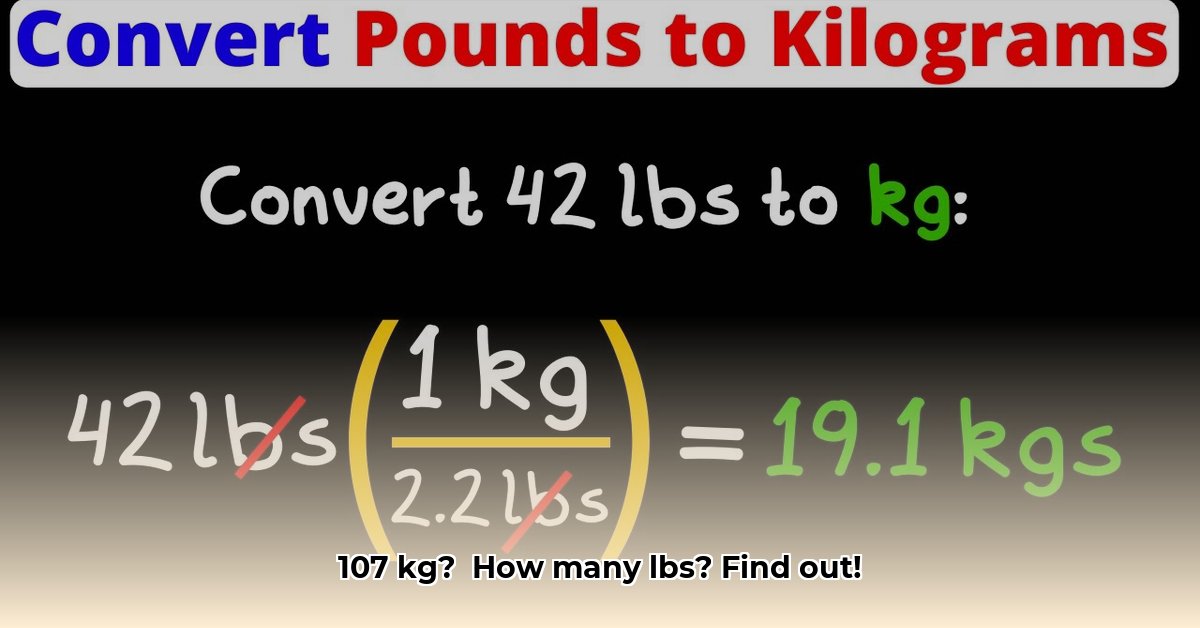Quick Conversion: Kilograms to Pounds
107 kg = 235.895 lbs (precise), ≈ 236 lbs (rounded)
Conversion Formula and Method
The formula for converting kilograms (kg) to pounds (lbs) is:
lbs = kg * 2.20462
Therefore, to convert 107 kg to pounds:
- Start with the weight in kilograms: 107 kg
- Multiply by the conversion factor: 107 kg * 2.20462 lbs/kg = 235.89434 lbs
- Round if necessary: For most practical purposes, this can be rounded to 236 lbs.
Understanding the Units: Kilograms and Pounds
The kilogram (kg) is the base unit of mass in the International System of Units (SI), the globally accepted standard for measurement. The pound (lb), while commonly used in the United States and a few other regions, is often considered a unit of mass or weight, depending on context in those regions. It’s important to note that while we often use mass and weight interchangeably in casual conversation, scientific definitions do distinguish between them. Mass refers to the amount of matter in an object, which is a constant property, while weight is the force exerted on that mass by gravity, varying depending on the gravitational field.
Conversion Table
| Kilograms (kg) | Pounds (lbs) (approximate) |
|---|---|
| 105 | 231 |
| 106 | 233 |
| 107 | 236 |
| 108 | 238 |
| 109 | 240 |
| 110 | 242 |
Practical Applications and Real-World Examples
Understanding the conversion between kilograms and pounds has numerous practical applications:
- Travel: Knowing your luggage weight in both kilograms and pounds can help you avoid excess baggage fees, especially when traveling internationally. Airlines typically specify baggage allowances in either kilograms or pounds, so being able to convert between the two is essential.
- Shipping: Accurate weight conversions are critical for calculating shipping costs and complying with weight restrictions. Whether you’re sending a small package or a large freight shipment, precise weight information is essential for smooth and cost-effective shipping.
- International Commerce: Global trade often necessitates converting between metric and imperial units. Accurate weights are crucial for customs declarations, tariffs, and pricing agreements, and even small discrepancies can have substantial financial implications.
- Science and Engineering: In scientific research and engineering projects, precise measurements, including weight conversions, are paramount. Accurate conversions ensure data integrity and the safety and stability of structures or experiments.
- Medicine and Healthcare: Precise weight measurements in kilograms are frequently used in medicine for determining drug dosages, calculating body mass index (BMI), and monitoring patient health. Accurate conversions ensure the safe and effective administration of medications and treatments.
- Culinary Arts: Precise conversions are valuable in the culinary world, particularly when adapting recipes from different regions or scaling recipes up or down. Accurate conversions ensure consistent results, especially in baking, where ingredient proportions are crucial.
- Fitness and Sports: Many fitness and sports activities utilize weights measured in kilograms (e.g., weightlifting, Olympic lifting). Understanding the conversion to pounds allows individuals to track their progress, compare performance with others, and accurately assess their strength and conditioning.
Visualizing 107 kg might be easier by comparing it to the approximate weight of a fully grown male reindeer, a large silverback gorilla, or two hefty bags of cement.
Why Different Measurement Systems? History and Current State
The coexistence of kilograms and pounds stems from the historical development of different measurement systems. While the metric system, with its decimal-based structure and the kilogram as the base unit of mass, gained widespread international adoption, the imperial system, which includes the pound, remained prevalent in certain regions. Ongoing standardization efforts aim to promote the metric system globally, but both systems likely will continue to be used for the foreseeable future, making conversions like kg to lbs essential.
Accuracy and Ongoing Research
While the conversion factor 2.20462 is widely used and accepted, some experts suggest a slightly different factor for specialized applications requiring extreme precision. Ongoing research in metrology – the science of measurement – continues to refine our understanding of units and conversion factors. This suggests that while the current conversion methods are highly accurate for practical use, minor adjustments may occur with future scientific advancements. This highlights the dynamic nature of scientific understanding, as ongoing research and developments in metrology might refine conversion factors even further in the future.
It is important to provide context to the data and avoid stating information as 100% certain unless it is widely accepted as a fact. There might be varying perspectives on the exact conversion factors in specific scientific communities. Recognizing this complexity ensures accurate and nuanced information for a diverse audience.
- Lunch Box That Fits Bento Box Neatly for Daily Use - December 5, 2025
- Japanese Lunch Bag Does Double Duty as Bento Carrier and Tote - December 4, 2025
- Your Perfect Bento Box Bag For Fresh And Tidy Meals - December 2, 2025










